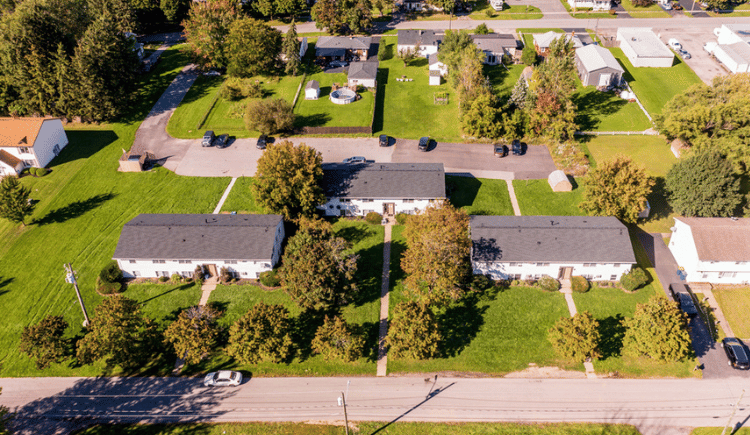One of the enduring points of debate among real estate investors over the last few years has been cap rate compression. We’ve written about it before in the context of inflation. While inflation tends to fluctuate with economic cycles, cap rates — at least in the workforce residential context we operate in — have shown a remarkably consistent pattern for years now: they just keep going down.
But a cap rate is just the ratio of a property’s net operating income to its market value. Or, since one of those numbers is usually a prediction, an asset’s cap rate describes the risk premium the market assigns it.
In other words, inflation should correlate with rising cap rates. At least, that’s the conventional wisdom. There’s three arguments behind the theory.
First, inflation tends to mean rising interest rates. When capital costs more, demand cools off. Cooling demand means falling market values. And, if you hold the numerator constant and shrink the denominator, you get a higher ratio. Hence rising cap rates. Second, inflation drives up the risk-free rate. When that happens, even if risk premiums remain constant, cap rates should increase too. Third, the risk premium might simply rise when the economy takes a hit.
The consistent downward pressure on cap rates in multifamily markets has some investors surprised. As inflation has increased over the last few months, we’ve seen very little cap rate movement. In fact, the risk premium has continued to fall — and cap rates with it. (At least in the assets we buy: workforce housing in the Heartland.) And in some sense, there’s little point arguing with the empirics: as a matter of fact, inflation is here and cap rates aren’t materially increasing.
The question is: why?
Liquidity preserves demand despite rising capital costs
First, a qualification: cap rates will rise eventually if interest rates stay elevated for long enough. That’s pretty inevitable. And other asset profiles are likely to see upward movement in cap rates before we do. For instance, Class A has nowhere to go but up, so there’s likely to be some movement there before too long.
But for our strategy, there hasn’t been upward movement yet. Our theory is that it’s because of liquidity. That’s the key that’s going to drive supply and demand changes for investment properties. Right now, there’s still abundant liquidity in the marketplace. That’s why there’s inflation.
But liquidity also blunts the impact of rising capital costs and preserves demand for cash-flowing assets. Put simply, it’s easier to hang on to demand when the market is flush with cash.
Add to that the fact that asset valuations have come back to earth in many asset classes (like public markets; crypto; and private, late-stage tech companies). That fact matters for two reasons.
First, real estate typically lags behind those asset classes. They might signal what’s coming for real estate in the future, but they don’t mean much as a near-term prognosis for real estate valuations.
Second, they might actually drive real estate demand up. Demand for real estate is typically fairly recession-proof, which is part of why it’s commonly thought to be an effective hedge against inflation. And when investors think of real estate as a hedge against inflation, that perception can become a self-fulfilling prophecy. Other assets struggling could presage a huge cash exodus, and investors looking for a safe harbor often wind up increasing real estate demand.
Of course, if the coming recession gets too protracted, and liquidity dries up, valuations might fall and cap rates might rise.
But in the near future, cap rates staying constant — or even compressing more — is not out of the question. Even when rates rise, cap rates are a function of investment demand, and the current shakiness of virtually every other corner of capital markets may well just prove — yet again — that multifamily is incredibly resilient.
What does that mean for investors?
If that theory winds up coming true, we could see already-low cap rates shrink further as investor demand increases. And demand might actually be likely to increase as mass sell-offs in other categories (looking at you, stocks and crypto) flood the market with money that’s looking for a home.
And if that happens, it’ll just fuel the cycle. More liquidity heads to multifamily → cap rates continue to fall. Of course, if multifamily cap rates fall too far, then they’ll have to spring back eventually. Frothy valuations will only last so long if the economy takes a royal beating, and cap rates in the 1% have never been stable. But that’s the extreme scenario. For the foreseeable future, we wouldn’t be surprised if investors continued to ride the wave of cap rate compression.
As interest rates inflate and the cost of debt rises, risk rises too. Add to that the fact that panic selling in other asset classes could herd investors into perceived safe harbors, and investors may well be willing to accept just-okay returns in multifamily because the asset is perceived as pretty safe.
And because cap rates are also a pretty standard proxy for projected returns, investors willing to accept “just okay” returns are going to keep demanding lower cap rate properties.
Meanwhile, investors can afford to get more aggressive on cap rates if they’re making a couple of fairly standard assumptions:
- Pricing higher inflation expectations into deals.
- Pricing in an anticipated rate cut (say, in a year or so once the economy stabilizes).
For investors looking to buy, valuations will be the key differentiator between success and failure. Cap rates have never been a perfect proxy, but investors who predict values better will come out on top. Getting more aggressive on cap rates is probably a fairly safe bet in an inflationary environment. And ever-falling cap rates are good news for investors who are hoping to see some appreciation on exit. But it’s also worth bearing in mind that, although it has been a remarkably stable trend over time, cap rates probably won’t fall forever. In theory, cap rates could keep falling indefinitely, but only if the rate of compression continues to slow over time, which means investors make less at the margin.

